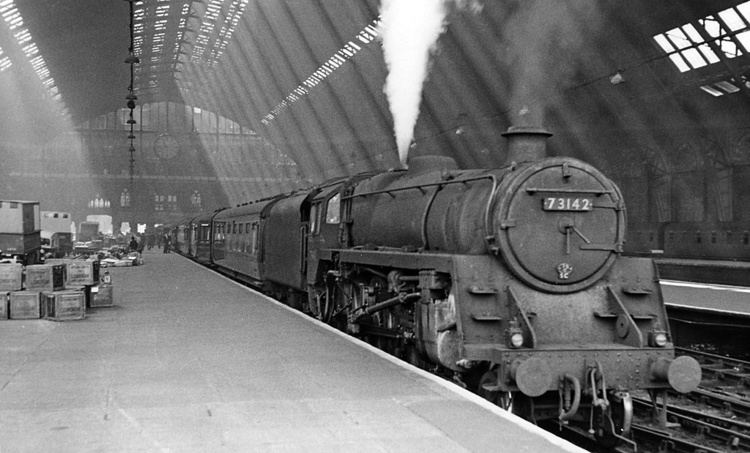Power type Steam Build date April 1951 - June 1957 | Designer R. A. Riddles Total produced 172 | |
 | ||
Builder BR Derby Works (130)BR Doncaster Works (42) | ||
The British Railways Standard Class 5MT 4-6-0 was one of the 12 standard classes of steam locomotive built by British Railways in the 1950s. It was essentially a development of the LMS Stanier Class 5 4-6-0 ("Black Five"). 172 were built between 1951 and 1957.
Contents
Background
William Stanier's Black Five had been the most successful mixed-traffic type in Great Britain. Construction of the Black Fives had started in 1934 and continued past nationalisation to 1951. A new set of 'standard' locomotives was to be built by British Railways, based on LMS designs and incorporating modern ideas.
In particular, the Standard design incorporated features designed to make disposal easier: a self-cleaning smokebox and a rocking grate removed the necessity for crews to undertake dirty and strenuous duties at the end of a long shift. The Standard 5 was a much more economical high speed express engine than the Black 5. Like the "Clan" class locomotives, Standard 5s, with their high-stepped running board, were partly conceived to be more economical and serviceable replacements for the Bulleid Pacific, and the Standard Class 5 were fast, they could really fly with good steam, easily to 100mph in the view of many engine drivers. Like the Clans, which could only manage one more carriage on an express than a 'Five' the Standard Fives took a long time to shake down, and only started to really pull when different firing techniques, which allowed them to steam using poor quality coal were developed, for these low emission passenger locomotives, came into use. They pulled much of the traffic on the last express lines for steam in the mid and late 1960s: Edinburgh-Aberdeen, London- Southampton-Bournemouth- Weymouth and local express traffic in the North and Midlands around Sheffield and Leeds. They were also used on the locals between Liverpool, Manchester and Blackpool, some steam hauled to the last day of steam in 1968.
Design and construction
The design work was done at the ex-LNER Doncaster Works but the bulk of the construction was done at Derby Works. The locomotive featured a BR standard boiler very similar in dimensions to the Stanier Type 3B fitted to the Black Fives, but made from manganese steel instead of nickel steel. The most obvious visible changes were a higher running plate, slightly enlarged driving wheels (from 6 ft 0 in (1.829 m) to 6 ft 2 in (1.880 m)), a standard cab with external pipework and the regulator gland on the drivers side of the boiler below the dome.
The first of the class, 73000, was outshopped from Derby in April 1951 and 30 were in service by January 1952. There was then a gap in construction before Derby resumed building its remaining 100 engines. 42 were built at Doncaster, starting in August 1955 and finishing in May 1957, with Derby's last engine following a month later.
Thirty engines, numbers 73125 to 73154, were built with Caprotti valve gear and poppet valves. One of these engines (73129) survives today at Butterley. It and 71000 Duke of Gloucester are the only engines with Caprotti gear left in Britain.
In service
In 1959, 20 of the Southern Region locomotives were named, the names being transferred from SR King Arthur class locos that were then being withdrawn. These were:
73020 is known to have been used on Southern Region, photographed departing Southampton Terminus on 18 September 1965.
73022 has also been photographed in service on the Southern Region, pulling a boat train across Canute Road in Southampton on 29 September 1966. This engine also starred in the BTC film Wash and Brush Up, showing the routine boiler washout and cleaning of the smokebox and ash screens every 12–16 days while in service. On completion of this, 73020 hauled the 12.10pm goods to Camden.
73114 Etarre has been photographed in service on 20 March 1966, pulling a boat train through Fareham while diverted due to electrification work on the Southern Region mainline from Southampton to London Waterloo.
73116 'Iseult' is seen, at the head of a Southampton boat train, in 'Terminus', the 1961 British Transport Film documentary directed by John Schlesinger which presents a "fly-on-the-wall" look at a day at Waterloo Station in London.
Preservation
Only five members of the class have survived into preservation and of the 5 only 73096 has operated on the mainline. 73096 Is currently undergoing an overhaul at Southall and is being done to mainline standard.
